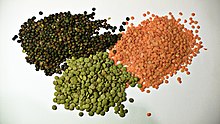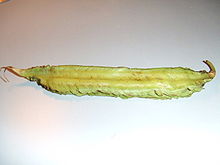Bean

Bean is a common name for large plant seeds of several genera of Fabaceae (formerly Leguminosae) used for food or feed.
Name
The term Bean originally referred to the seed of the broad bean, but was later broadened to include members of the genus Phaseolus such as the common bean or haricot and the runner bean and the related genus Vigna. The term is now applied in a general way to many other related plants such as soybeans, peas, lentils, vetches and lupins. Bean can be used as a near synonym of pulse, an edible legume, though the term "pulses" is usually reserved for leguminous crops harvested for their dry grain. Pulses usually excludes crops mainly used for oil extraction (like soybean and peanut) or those used exclusively for sowing purposes (clover and alfalfa). Leguminous crops harvested green for food, such as snap beans, green peas etc, are classified as vegetable crops.
In English usage 'beans' sometimes also refer to seeds or other organs of non leguminosae which bear a resemblance to the vegetable, for example coffee beans, castor beans and cocoa beans (which resemble bean seeds), and vanilla beans (which resemble the pods)
Types of beans
- Vicia
- Faba or broad bean

Vica faba (broad bean)
- Faba or broad bean
- Vigna
- Aconitifolia or Moth bean
- Angularis or azuki bean
- mungo or urad bean
- radiata or mung bean
- umbellatta or rice bean
- unguiculata or cowpea (includes the black-eyed pea, yardlong bean and others)
- Cicer
- arietinum or chickpea
- Pisum
- sativum or pea
- Lathyrus
- Lathyrus sativus (Indian pea)
- Lathyrus tuberosus (Tuberous pea)
- Lens
- culinaris or lentil

Lentils
- culinaris or lentil
- Lablab
- purpureus or hyacinth bean
- Phaseolus
- acutifolius or tepary bean
- coccineus or runner bean
- lunatus or lima bean
- vulgaris or common bean (includes the pinto bean, kidney bean and many others)
- Glycine
- max or soybean
- Psophocarpus
- tetragonolobus or winged bean

Psophocarpus tetragonolobus (winged bean)
- tetragonolobus or winged bean
- Cajanus
- cajan or pigeon pea
- Stizolobium
- spp or velvet bean
- Cyamopsis
- tetragonoloba or guar
- Canavalia
- ensiformis or jack bean
- Macrotyloma
- M. uniflorum or horse gram
- Lupinus or Lupin
- L. mutabilis or tarwi
- Erythrina or Coral bean
Cultural aspects
The following traditional uses of beans refer to the broad bean.
- In some folk legends, such as in Estonia and the common Jack and the Beanstalk story, magical beans grow tall enough to bring the hero to the clouds. The Grimm Brothers collected a story in which a bean splits its sides laughing at the failure of others.
- Dreaming of a bean is sometimes said to be a sign of impending conflict, though others said they caused bad dreams. [citation needed]

- Pliny the Elder claimed that beans act as a laxative. He may have been referring to the seeds of the castor oil plant, which contain oils used as laxatives in ancient India.
- European folklore claims that planting beans on Good Friday or during the night-time is good luck.
- "Beans, Beans, the Musical Fruit" is a children's song about the flatulence often experienced after eating baked beans. The song is noteworthy for correctly identifying the bean as a fruit, not a vegetable.
- "Mame Chishiki", a Japanese phrase, means "bean knowledge" (not "knowledge of beans"). This is used to indicate any random trivia or miscellaneous knowledge displayed.
- In New Orleans, serving a meal of black-eyed peas on New Year's Day is thought to bring good luck in the upcoming year.
Toxins
Some raw beans, for example kidney beans, contain harmful toxins (lectins) which need to be removed, usually by various methods of soaking and cooking. The soaking water from kidney beans should be discarded before boiling, and some authorities recommend changing the water during cooking as well.[citation needed] Cooking beans in a slow cooker, because of the lower temperatures often used, may not destroy toxins even though the beans do not smell or taste 'bad'[1] (though this should not be a problem if the food reaches boiling and stays there for some time).
Flatulence
Many edible beans, including broad beans and soybeans, contain oligosaccharides, a type of sugar molecule also found in cabbage. An anti-oligosaccharide enzyme is necessary to properly digest these sugar molecules. As a normal human digestive tract does not contain any anti-oligosaccharide enzymes, consumed oligosaccharides are typically digested by bacteria in the large intestine. This digestion process produces flatulence-causing gasses as a byproduct. This aspect of bean digestion is the basis for the children's rhyme "Beans, Beans, the Musical Fruit."
Some species of mold produce alpha-galactosidase, an anti-oligosaccharide enzyme, which humans can take to facilitate digestion of oligosaccharides in the small intestine. This enzyme, currently sold in the U.S. under the brand-name Beano, can be added to food or consumed separately.
See also
Notes and references
- ^ Phytohaemagglutinin, US FDA's Bad Bug Book or Foodborne Pathogenic Microorganisms and Natural Toxins Handbook. Notes that toxicity may be greater if heated to 80 °C than if consumed raw.
External links
- Beans for the home gardener
- Everett H. Bickley Collection, 1919-1980 Archives Center, National Museum of American History, Smithsonian Institution.
- Discovery Online: The Skinny On Why Beans Give You Gas
- Bulgarian Guide: Bean Soup Recipe



